Impact of COVID-19 lockdown on dietary and lifestyle behaviours among adolescents in Palestine
Hala Allabadi1, Jennifer Dabis1, Varsen Aghabekian1, Amer Khader1, Umaiyah Khammash1
1Juzoor for Health and Social Development, Al-Arkan Street, Al-Bireh, West Bank
Correspondence: Hala Allabadi: allabadi.hala@gmail.com
Keywords: COVID-19, adolescent obesity,
Received: 5/6/2020; revised 8/6/2020; Accepted: 12/6/2020
[citation: Allabadi, H. et al. (2020). Impact of COVID-19 lockdown on dietary and lifestyle behaviours among adolescents in Palestine. DHH, 7(2):http://www.journalofhealth.co.nz/?page_id=2170].
Abstract
Background: The Coronavirus (COVID-19) pandemic has led to the enforcement of home confinement and the prolonging of school closures, indefinitely. There is a pressing need to call attention to the pandemic’s longer-term effect on children’s and adolescents’ health and well-being. The aim of this study was to assess the impact of the country-wide lockdown on dietary and lifestyle behaviours of adolescents in the West Bank, Palestine. Methods: The study was conducted on a sample of 600 adolescents (10-19 years old) in the West Bank, Palestine. Participants were selected for the study using randomly generated phone numbers and snowball sampling. Interviews were conducted by telephone to assess:dietary habits, physical activity, screen time, sleeping patterns, sources of stress and socio-demographics. Results: Among our sample, there was an increase in weight gain, food intake, consumption of non-nutritional foods, screen time and sleeping hours as well as a decrease or lack of physical activity in comparison to before the lock down. Weight gain was independently associated with increased food intake. Conclusion: Recognizing the adverse effects of the COVID-19 pandemic and integrating dietary and lifestyle programs into lockdown conditions and school closures is critical for adolescents’ long-term health.
Keywords: COVID-19, adolescents, behaviours, nutrition
Introduction
As the Coronavirus (COVID-19) pandemic is still ongoing, it has created a profound impact socially, physically and economically on families across the globe. With confinement laws and regulations still being enforced, health care systems are deteriorating, economies are shutting down and school closures are being extended. These restrictions are leading to severe repercussions on individuals’ daily routines and lifestyle behaviours including food access and consumption, outdoor activities, travel, school-related functions, and access to many forms of leisure and exercise (1). Particularly alarming are the implications of the lockdown on irregular eating habits, excessive snacking and lack of physical activity, all of which are associated with high-calorie intake and increased risk of obesity (2). Similarly, home confinement leads to an increase in sedentary behaviours that lead to low levels of energy and mainly activities involving an excessive amount of sitting (3). These changes in dietary and lifestyle-related habits during the COVID-19 outbreak could be associated with feelings of fear, anxiety, and stress, which many people may be experiencing around the world (4).
As of the end of March, 2020, more than 150 million children and adolescents around the world have been affected by school closures (5). Under the current restrictive measures and the prolonging of school closures indefinitely, there is a pressing need to call attention to the pandemic’s longer-term effect on children and adolescent health and well-being. It is well recognized that when children are out of school (e.g. weekends and summer holidays), they are physically less active, more sedentary, sleeping more often, and follow less favorable diets, all of which result in weight gain (6). Such negative effects on health are likely to be much worse when children are confined to their homes (7).
In the context of Palestine, the longstanding Israeli-Palestinian conflict has led to major barriers including restrictions to movement, lack of control on borders including import/export processes, lack of control on natural resources including water, limited resources and access to healthcare, and a compromised economy with high unemployment. The current COVID-19 crisis and the imposed countrywide lockdown exacerbates the difficult living situation and exposes the Palestinians to further vulnerabilities and stress. It is assumed that families living in the most marginalized areas of Palestine and those already recognized as vulnerable populations are likely to be the most impacted amidst this crisis.
As school closures are extended in Palestine, it is no surprise that the COVID-19 crisis and lockdown could potentially be affecting children’s and adolescents dietary and lifestyle habits. Being forced to stay at home increases students’ exposure to weight gain and obesity risk factors such as overeating, comfort eating, consumption of unhealthy food, physical inactivity, and minimal stimulation. This is extremely alarming as Palestine is already increasingly affected by the double burden of malnutrition: the persistence of under-nutrition, combined with a rapid rise in overweight and obesity (8). In a recent report in 2014, the prevalence of overweight and obesity among Palestinian school children was 18.6% and 7.24%, respectively. The prevalence of stunting found in the same study was 7% (9). In general, children start school with moderate stunting and underweight, however, by high school, overweight starts to become observed, particularly among girls (10).
The increasing problem with childhood obesity requires particular attention. If unattended to, it becomes problematic, as children and adolescents who are overweight and obese are likely to be obese in adulthood, and more likely to acquire non-communicable diseases (NCDs) at a younger age (11). With school closures imposed indefinitely, this may exacerbate the epidemic of childhood obesity and increase disparities in obesity risk.
Under the emergency lockdown situation, it is likely that nutrition and obesity are not priority policy issues due to mounting problems and needs in all realms. However, despite the overwhelming issues, it is critical to tackle children’s and adolescents lifestyle behaviours with the added challenges of COVID-19.
To date, there is little evidence to evaluate the effect of home confinement on lifestyle behaviours among children and adolescents, and particularly if , children and adolescents are spending less time being physically active, going to bed later, sleeping in later, and spending more time sedentary, with increased screen time. It is crucial to investigate how individual behaviour changes over time under lockdown conditions, and how crises such as the COVID-19 pandemic may directly impact the behaviour and health status of populations, particularly children and adolescents. Similarly, with child and adolescent obesity on the rise in Palestine, the situation could be worsened by the current challenges of the pandemic and its negative effects on dietary and lifestyle habits of Palestinian children and adolescents.
Therefore, the aim of this study was to assess changes in lifestyle behaviours of adolescents in the West Bank, Palestine during the country-wide lockdown, in comparison to before the lockdown. Specifically, the study will assess: 1) the impact of the COVID-19 lockdown on changes in weight, dietary habits and lifestyle behaviours including physical activity, sleep patterns and screen time; 2) the association between changes in weight and food intake, physical activity, screen time, sleep patterns and sources of stress; 3) gender differences in weight, dietary habits, physical activity, screen time and sleep patterns among Palestinian adolescents during the lockdown.
Methods
Study design and population
The study was conducted on a sample of 600 adolescents residing in all governorates in the West Bank, Palestine during the period between April 24 and April 27, 2020. Participants were eligible if they were between 10 and 19 years of age. Subjects who consented to participate in the study were interviewed by telephone by trained researchers using a structured questionnaire, developed by the authors of the study. Phone interviews lasted between 10-15 minutes. In total, 65.7% of the sample was chosen using randomly generated phone numbers and 34.3% were chosen using snowball sampling. The data was also collected using the snowball technique for time purposes as a large number of households did not have 10-19 years old living at the residence. One adolescent participant was randomly selected from each household using the Kish selection grid, a method for selecting members within a household to be interviewed. Verbal informed consent was obtained from parents/legal guardians of all eligible participants after explanation of the study including objectives, confidentiality and benefits of the study. The interview was completely confidential and all participants are anonymized in dissemination reports. The study protocol was reviewed and approved by the Helsinki Ethics Committee of the Palestinian Health Research Council in the Gaza Strip.
Study variables
The questionnaire assessed a range of lifestyle behaviours including dietary habits, physical activity, screen time, and sleep patterns, as well as socio-demographic factors and sources of stress during the lockdown. All questions were structured to be answered directly in comparison to “before” or “during” confinement conditions. The questionnaire was translated from English to Arabic and back-translated from Arabic to English by two bilingual experts.
Socio-demographic factors
Sex, age, social status, education, occupation, residence, household size and family’s financial situation.
Dietary habits
Increase/decrease in weight, increase/decrease in frequency of food consumption, and increase/decrease in dietary intake (sugar-added drinks, vegetables, fruits, dairy products, canned foods, fried foods, sweets and sugars).
Physical activity
Days of physical activity conduct per week; increase/decrease in physical activity.
Screen time
Increase/decrease in screen time watching television and using computers/tablets/mobiles; hours spent on the television per day; hours spent on computers/tablet/mobiles per day; hours spent on the screen for school-related functions.
Sleep patterns
Hours of sleep per day; increase/decrease in sleep
Sources of stress
Participants were asked if the following factors were causing stress in their daily lives during the lockdown: staying at home all day, distance learning, housework, not going to work, current financial situation, distance from family members, distance from friends, and family relationships.
Statistical methods
Descriptive statistics of the participants’ characteristics are provided as mean and standard deviation (SD) for continuous variables and frequency and percentages for categorical variables. The dependent variable in the analysis was weight change. Bivariate analyses were conducted to assess associations between weight change and lifestyles variables, including food consumption, dietary habits, physical activity, sleep patterns, screen time, sources of stress and socio-demographic factors, and are described using Chi-Squared test or Student’s t-test, as appropriate. Multinomial logistic regression analyses were performed to assess the independent association between weight change and dietary habits, lifestyle variables, sources of stress, and socio-demographic factors. Statistical significance was defined as a two-sided p-value <0.05. All data was analyzed using the STATA Data Analysis and Statistical Software, version 14.
Results
In total, 600 adolescents were eligible and approached for an interview. Characteristics of the participants are presented in Table 1.
Socio-demographic factors
Among the sample (N=600), 50.0% were males and 50% were females. The average age of the participants was 14.1±2.9 (range 10-19 years). The majority of the participants were not married (99.8%), lived in cities (71.5%), and were students (96.2%), with approximately 80.0% in primary or middle school. The average household size of participants was 6.3±1.9. Approximately 343 (57.0%) of the sample reported their family’s financial situation became worse during the lockdown in comparison to before the beginning of the confinement period.
Table 1. Characteristics of study sample
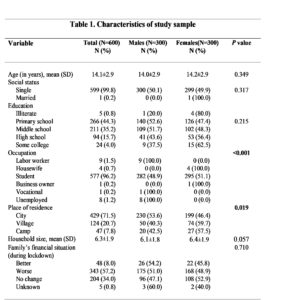
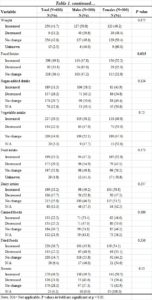
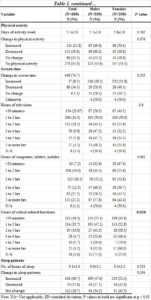
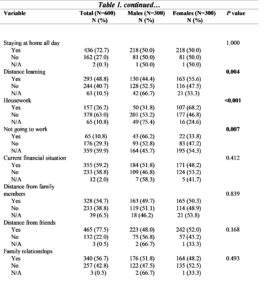
Sample characteristics for dietary habits, physical activity, screen time, sleep patterns, sources of stressNote. hrs=hours; SD=standard deviation; NA= not applicable. P values in bold are significant at p < 0.05.
Among the total sample, 250 (41.7%) reported that they gained weight and 299 (50.0%) of adolescents reported that their food intake increased compared to before the lockdown. In regards to nutrition intake, 189 (31.5%) reported an increase in sugar-added drinks (soda, processed juices etc.); 237 (39.5%) reported an increase in vegetable intake, while 199 (33.2%) reported an increase in fruit intake. Two-hundred and fifteen (35.8%) and 184 (30.7%) of participants reported no changes in their intake of dairy products and canned food, respectively. Additionally, 220 (36.7%) reported an increase in their intake of fried foods, while 279 (46.5%) reported an increase in sweets and sugar-added food in comparison to before the lockdown.
Two-Hundred and seventy (45.0%) adolescents reported no physical activity (e.g. walking, running, home exercises) during the lockdown, while 29.5% reported exercising one to three times per week. Among those reporting some sort of exercise, 131 (21.8%) reported an increase, while 113 (18.8%) reported a decrease in their physical activity.
Four-hundred and forty eight (74.7%) reported they were spending more time watching television and using computers/tablet/mobiles during the lockdown compared to before: the majority (78.5%), reported watching television between one to three hours per day during the lock down, while 53.0% reported spending four or more hours on the computer/mobile/tablet during the lockdown.
The average hours of sleep per day during the lockdown was nine. Four-hundred and eighteen (69.7%) reported sleeping more during the lockdown compared to before the lockdown.
The most common stressors reported by both males and females were staying at home 436 (72.7%), being away from friends 465 (77.5%), financial situation 355 (59.2%), and family relationships 340 (56.7%).
Gender differences among sample
In general, food intake compared to before the lockdown increased significantly more in females than in males (p=0.013). However, there were no significant differences for weight change between females and males. In regards to intake of the different food groups, males were found to consume sugar-added drinks more than before the lockdown compared to females; and females were found to consume fried foods more than before the lockdown compared to males; no differences were found among males and females in consumption of sweets compared to before the lockdown.
Findings revealed females were more likely to be physically inactive than males during the lockdown (p=0.07), in comparison to before the lockdown. In contrast, a decline in physical activity levels was reported more among males than females during the lockdown.
Both females and males reported sleeping on average nine hours a day during the lockdown. Among the total sample, females reported sleeping more during the lockdown compared to males, however this association was not significant.
In general, males were more likely to spend five or more hours on their mobile/tablet during the lockdown than females, however there were no significant gender differences found for changes in screen time during the lockdown in comparison to before the lockdown.
Females were more likely to report housework (p<0.001) and distance learning (p=0.004) as being major stressors during the lockdown compared to males. No other major gender differences were reported in regards to stressors during the lockdown.
Relationship between weight change and food intake, types of food consumed, physical activity, sleep patterns, screen time, and other factors
The bivariate analysis suggests that weight gain was more likely among those with increased food intake (p<0.001); those who reported more cooking (p<0.001); those who consumed more sugar-added drinks (p<0.001), fried foods (p=0.07), sweets (p<0.001); those who reported no physical activity during the lockdown (p=0.05); and those who reported increased screen time during the lockdown (p=0.001).
Additionally, among those who reported an increase in their weight were those who reported their family financial situation became worse during the lockdown (p<0.001).
Among those who reported weight gain were those who reported an increase in their sleep patterns, and those who were in primary school. However, these associations were not significant. No significant association was found for weight change and age.
Adolescents who reported their family’s financial situation became worse during the lockdown also reported increased food intake and weight (p<0.001), an increase in sugar-added drinks, increased intake of canned food (p=0.013), increased intake of sweets (p=0.005), and either reported an increase or no change in intake of dairy products (p=0.03) compared to before the lockdown. Similarly, among the same proportion of the sample, it was reported that there was an increased intake of fried food. However, this association was not significant.
Among all stressors, , staying at home, distance learning, not going to work, financial situation, distance from family and friends, and family relationships at home were significantly associated with increased weight and significantly associated with increased food intake during the lockdown.
There was no association for the relationship of financial situation with weight and household size. There were no significant associations found for the relationship between type of residence (e.g. city, village, camp) and food consumption and weight change during the lockdown. Additionally, there was no association found between place of residence and financial situation. In contrast, it was revealed adolescents living in camps more frequently reported increased intake of canned foods (p=0.002) and fried foods during the lockdown compared to those living in cities and villages.
Factors associated with weight change
Multinomial logistic regression was performed to determine the independent association of food intake, types of food consumed, physical activity, sleep patterns, screen time, and socio-demographic factors with weight change (Table 2). Findings revealed the increase in food intake during the lockdown was independently associated with increased weight (p<0.001). However, there was no independent association found for the relationship between increased weight and physical inactivity, increased hours of sleep, nor increased screen time. Increased weight was associated with increased intake of dairy products (p=0.005), however it was not associated with any other food group. Among the socio-demographic factors, it was found that participants’ family financial situation was independently associated with increased weight (p=0.057). No other factors such as sex, age, residence, or years of education were independently associated with change in weight in the regression analyses.
Table 2. Factors associated with weight change among sample in multinomial logistic regression
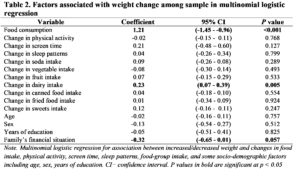
Discussion and conclusionNote. Multinomial logistic regression for association between increased/decreased weight and changes in food intake, physical activity, screen time, sleep patterns, food-group intake, and some socio-demographic factors including age, sex, years of education. CI= confidence interval. P values in bold are significant at p < 0.05
The ongoing COVID-19 pandemic has become a major public health concern and has changed the daily lives of citizens across the globe. The present study revealed a substantial increase in weight gain, food intake, consumption of non-nutritional foods, screen time and sleeping hours as well as a decrease or lack of physical activity in comparison to before the lockdown among our target population. Additionally, among adolescents who reported increased weight compared to before the lockdown were those with increased food intake, increased intake of sugar-added drinks, fried foods and sweets, those who reported no physical activity and those which reported increased screen time during the lockdown. Our study further highlights the negative impact of the COVID-19 lockdown on the financial situation of many Palestinian families, which led to the increased intake of energy-dense and poor micronutrient foods among our sample. With the extension of school closures and loss of jobs amongst Palestinian families, there will be a lasting impact on dietary and lifestyle behaviours, posing long-term challenges for children and adolescents. Our findings point to the need for integrating specific diet and lifestyle interventions during lockdown conditions and school closures by promoting healthy living into children’s and adolescents’ daily routines.
There is currently a gap of knowledge in the short and long-term impact of the COVID-19 lockdown on health behaviours among adolescents. To our knowledge, this is the first study to assess the effects of the lockdown on dietary and lifestyle behaviours among this target population in Palestine. The findings from our study are similar to those found in a study conducted in Verona, Italy, which assessed factors contributing to weight gain among children and adolescents during the lockdown and also found increased food consumption, increased intake of non-nutritional foods, increase in screen time and sleeping hours and a decrease in physical activity during the lockdown (12). Moreover, particularly alarming in our study were the high rates of physical inactivity (50.0%) and the increase in sedentary behaviour for screen time during the lockdown (75.0%), consistent with findings from another study in China. Reduced physical activity and increased sedentary behaviours may negatively impact children’s and adolescents’ physical and mental health.
Therefore, governments, schools, health professionals and parents need to be aware of the severe impact of the COVID-19 lockdown and implement effective dietary and physical activity interventions specifically under lockdown conditions to minimize the negative impact of the COVID-19 pandemic on children’s and adolescents’ health. Specific recommendations would be to develop and use virtual spaces and telemedicine programs to promote nutritional and physical activity programs in children’s and adolescents’ daily routines during lockdowns and closures. Programs could focus on promotion of outdoor activities while observing distancing regulations, conducting at least 60 minutes daily of activity of moderate intensity, reduction in screen time (no more than two hours per day), increased intake of fruits and vegetables, restrict intake of energy-dense, micronutrient-poor foods (e.g. packaged snacks) and sugar-sweetened soft drinks, and promote specific meal times during the day. Additionally, educators should promote physical activity behaviours, and use the opportunity to incorporate healthy movement messages, practices, and policies into daily home-school routines and lessons.
In the aftermath of the COVID-19 lockdown, stakeholders should work closely with national health policy-makers to provide online mental health resources to guide adolescents and their families through the stress and tension they are experiencing during and after the COVID-19 lockdown.
In terms of research, it is recommended to conduct further research to understand how individual behaviour changes over time under lockdown conditions, and how such crises may directly impact the behaviour and health status of populations, specifically children and adolescents. Findings from the current study can be the basis for developing program-specific national guidelines and protocols on dietary and lifestyle behaviours under lockdown conditions. This study will inform public health policies, and, in particular, will contribute to policy planning for future pandemic crises in regard to dietary and lifestyle behaviours. It is necessary that policy makers prioritize the obesity epidemic, specifically among adolescents, in combination with the longer-term effects of the COVID-19 lockdown on adolescent behaviours as an urgent public health matter with coordinated public and private sectors.
Acknowledgements
The Authors would like to thank Jerusalem Media Communication Center for the conduct of the data collection.
Competing interests
The authors declare that they have no competing interests.
References
- Hossain M, Sultana A, Purohit N. Mental health outcomes of quarantine and isolation for infection prevention: A systematic umbrella review of the global evidence2020.
- Scully M, Dixon H, Wakefield M. Association between commercial television exposure and fast-food consumption among adults. Public health nutrition. 2008;12:105-10.
- Hobbs M, Pearson N, Foster PJ, Biddle SJ. Sedentary behaviour and diet across the lifespan: an updated systematic review. British journal of sports medicine. 2015;49(18):1179-88.
- Anton SD, Miller PM. Do negative emotions predict alcohol consumption, saturated fat intake, and physical activity in older adults? Behaviour modification. 2005;29(4):677-88.
- Xiang M, Zhang Z, Kuwahara K. Impact of COVID-19 pandemic on children and adolescents’ lifestyle behaviour larger than expected. Progress in Cardiovascular Diseases. 2020.
- Lin Y, Tremblay MS, Katzmarzyk PT, Fogelholm M, Hu G, Lambert EV, et al. Temporal and bi-directional associations between sleep duration and physical activity/sedentary time in children: An international comparison. Preventive medicine. 2018;111:436-41.
- Brazendale K, Beets MW, Weaver RG, Pate RR, Turner-McGrievy GM, Kaczynski AT, et al. Understanding differences between summer vs. school obesogenic behaviours of children: the structured days hypothesis. The international journal of behavioural nutrition and physical activity. 2017;14(1):100.
- Palestinian Central Bureau of Statistics: Multiple Indicator Cluster Ssurvey 2014. In. Ramallah: Palestinian Central Burea Of Statistics. 2015.
- Ministry of Health Nutrition Department: National Nutrition Surveillance System 2014 Report. Ramallah, 2014.
- Massad S, Deckelbaum RJ, Gebre-Medhin M, Holleran S, Dary O, Obeidi M, et al. Double Burden of Undernutrition and Obesity in Palestinian Schoolchildren: A Cross-Sectional Study. Food and nutrition bulletin. 2016;37(2):144-52.
- Mikki N A-RH, Awartani F, Holmboe-Ottesen G. Prevalence and sociodemographic correlates of stunting, underweight, and overweight among Palestinian school adolescents (13-15 years) in two major governorates in the West Bank. BMC public Health. 2009;9:485-96.
- Pietrobelli A, Pecoraro L, Ferruzzi A, Heo M, Faith M, Zoller T, et al. Effects of COVID-19 Lockdown on Lifestyle Behaviours in Children with Obesity Living in Verona, Italy: A Longitudinal Study.n/a(n/a).